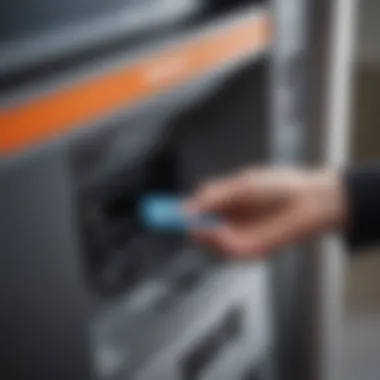Mastering Debit Card ATM Usage: A Complete Guide


Intro
Navigating the world of debit card ATMs can be both straightforward and complex. Understanding how to effectively use these machines is vital for financial independence and efficiency. With an increasing number of debit cards in circulation, it is essential to grasp the nuances surrounding their use at ATMs. This section aims to highlight the critical elements regarding accessibility, costs, and security that users must consider when utilizing debit card ATMs.
By knowing the intricacies of ATMs, individuals can make informed decisions enhancing their banking experience. It also helps users to manage their finances more effectively, avoiding unnecessary fees and ensuring their transactions are secure.
Understanding Debit Card ATMs
What is a Debit Card ATM?
A debit card ATM, or Automated Teller Machine, allows users to access their bank accounts electronically using a debit card. Debit cards are linked directly to a checking or savings account. When money is withdrawn or spent, it is deducted instantly from the linked account. This feature promotes responsible spending, as individuals can only access the funds available in their accounts.
Accessibility of ATMs
ATMs are widely available across urban and rural regions, ensuring users have convenient access to their funds. Banks and financial institutions typically own these machines, but third-party operators can also provide access. Understanding the locations of ATMs affiliated directly with your bank can save you from additional fees often associated with using third-party ATMs.
Fees Associated with ATM Transactions
Debit cards come with various fees, depending on the institution and ATM network utilized. It is crucial for users to be aware of these costs to avoid unnecessary deductions from their accounts. Common fees include:
- Withdrawal Fee: Charged when using an ATM outside of your bank's network.
- Balance Inquiry Fee: Fees may be charged for checking your account balance at non-affiliated ATMs.
- Foreign Transaction Fee: Some banks charge fees for international ATM usage.
Understanding these fees can foster better financial decisions and help users strategize how and where they access their money.
Security of ATM Transactions
Security is a paramount concern for users of debit card ATMs. Understanding potential threats, such as card skimming or unauthorized access, is essential for protecting financial information. Users are advised to:
- Inspect the ATM: Look for any suspicious devices attached to the card slot or keypad.
- Cover Your PIN: Use your hand to shield your numbers while entering them.
- Utilize Bank ATMs: Whenever possible, use machines directly operated by your bank for increased security.
Raising awareness about these safety measures can mitigate risks during transactions.
Technological Developments in ATM Usage
Emerging technology continually shapes how ATMs operate. Digital advancements improve efficiency and security. Features such as touchless transactions and mobile banking integration enhance user experience. With these changes, users need to stay updated on how technology may impact their ATM interactions.
The evolving nature of ATM technology necessitates a proactive approach to understanding its benefits and challenges.
By understanding these various aspects surrounding debit card ATMs, users can maximize their banking experience and maintain better control over their finances.
Intro to Debit Card ATMs
In today's fast-paced financial landscape, the role of Debit Card ATMs cannot be overstated. These machines provide a crucial service, allowing individuals to access their funds quickly and conveniently. Understanding the intricacies of Debit Card ATMs is important for anyone who wishes to manage their finances effectively.
Understanding Debit Cards
A debit card is more than just a plastic card. It is a direct link to an individual's bank account. The moment a transaction is made, the funds are withdrawn directly from the user's account, unlike credit cards where one borrows money to make purchases. Debit cards offer a straightforward approach to spending. Users have a clear sense of their available balance, which can aid in budgeting and avoiding debt. The security features of debit cards, such as PIN protection and fraud detection, add a layer of safety for the user.
Functionality of ATMs
The Automated Teller Machine, commonly known as an ATM, serves various functions that enhance consumer convenience. Primarily, ATMs allow users to withdraw cash, check their account balance, and transfer funds. Moreover, many ATMs have evolved to offer additional services such as bill payment and mobile top-ups. As technology advances, the functionality of these machines continues to expand.
When using an ATM, users insert their debit card, enter their PIN, and select the desired transaction. All these processes aim to create a user-friendly experience.
"ATMs not only offer convenience but also play a significant role in accessing cash around the globe."
Understanding how Debit Cards function at ATMs is essential for efficient banking. By being informed, individuals can save time and make better financial decisions.


The Importance of Accessibility
Accessibility is a fundamental aspect of using debit card ATMs. It ensures that individuals can easily obtain cash and manage their finances without unnecessary hurdles. With a growing reliance on electronic payments and debit cards, having access to ATMs becomes crucial for many users. This section emphasizes the significance of finding nearby ATMs and utilizing mobile applications to enhance convenience.
Finding Nearby ATMs
Finding nearby ATMs can greatly affect a user's banking experience. Equipped with a debit card, people often need immediate access to funds. The ability to locate the nearest ATM helps reduce the time spent searching for a cash withdrawal point. When ATMs are accessible, it minimizes stress and allows users to focus on other priorities.
To locate nearby ATMs effectively, consider the following aspects:
- Search Locally: Performing an online search for ATMs within your area can yield quick results. Many banks offer ATM locators on their websites.
- Bank Branches: Visiting the local branch of your bank can provide additional ATM accessibility. Bank branches often house ATMs for their customers, enhancing convenience.
- Signage: As you walk around urban areas, keep an eye out for signs indicating ATM locations. This is particularly useful in dense city settings where many ATMs exist.
With these methods, finding nearby ATMs becomes seamless. Users will feel empowered to access their funds as needed.
Mobile Applications for ATM Locating
Technology plays a prominent role in making financial services more accessible. Mobile applications dedicated to locating ATMs can simplify the process considerably. These applications provide real-time information, which is a valuable asset for users on the go.
Many banks and third-party developers offer applications that enable users to search for ATMs based on location. Here are some key benefits of using mobile applications for ATM locating:
- GPS Integration: Most applications utilize the GPS functionality of smartphones. This allows users to find ATMs closest to their current location.
- Filtering Options: Users can filter results based on specific criteria, such as free ATMs or those belonging to their bank, reducing fees.
- User Reviews: Some apps allow users to leave feedback and reviews for ATMs. This can provide insights into the safety and reliability of specific locations.
Adopting these mobile solutions fosters a greater sense of convenience. People can locate ATMs quickly while avoiding the frustration related to cash access.
The importance of accessibility in financial systems cannot be overstated. It represents empowerment for users, enabling them to make transactions anytime and anywhere.
Understanding Fees Associated with ATM Use
Understanding the fees associated with ATM use is crucial for anyone utilizing debit cards for banking. These fees can directly affect your financial well-being and spending habits. Not all ATMs charge the same fees, and knowing these differences can lead to smarter financial decisions. Users need to be informed about various fees to avoid unexpected costs and maximize the use of their debit cards. Understanding these fees can also help strengthen one’s credit management skills, ultimately enhancing financial health.
Transaction Fees Explained
When withdrawing cash from an ATM, you may encounter transaction fees, which are typically charged by the ATM owner. This fee can vary significantly based on location and the bank owning the ATM. Some banks do not charge their customers a fee for using their own ATMs, while others may impose a flat fee for each transaction.
- Factors Influencing Transaction Fees:
- ATM Ownership: Using machines owned by your bank usually incurs no charges.
- Location: ATMs located in convenience stores or tourist areas might charge higher fees.
- Account Type: Certain account types may have fee waivers or reduced charges.
In addition, many banks provide tools, such as mobile apps, which allow users to check for fees before making a withdrawal. Understanding these fees in advance can help avoid costs and allow for more budget-friendly cash management.
Foreign ATM Fees
Foreign ATM fees come into play when you utilize machines that do not belong to your bank’s network. This often occurs while traveling or in emergencies when immediate cash is necessary. Foreign ATM fees usually consist of the following components:
- Network Fees: This is a fee charged by the ATM operator for non-network withdrawals.
- Bank Fees: Your own bank may charge an additional fee for using a foreign ATM.
- Currency Conversion Fees: If you are abroad, your bank may apply a conversion charge when withdrawing in the local currency.
Evaluating the costs associated with using ATMs outside your network can prevent unpleasant surprises. Users may want to consider alternative ways to obtain cash while traveling, such as getting cash directly from bank branches that belong to their own bank's network whose withdrawal limits are often higher than those of ATMs.
In summary, being knowledgeable about transaction fees and foreign ATM fees can lead to better-informed decisions regarding cash withdrawal. This understanding ties back to enhancing your overall financial literacy.
Safety and Security Considerations
Safety and security are critical elements when using debit card ATMs. Understanding how to mitigate risks associated with ATM transactions not only protects your financial assets but also builds confidence in the banking system. Users must be aware of potential threats and take proactive measures to ensure secure banking practices.
Recognizing Safe ATM Locations
Identifying safe ATM locations is crucial for safeguarding your finances. Prioritize ATMs situated in well-lit, populated areas, often near bank branches, shopping centers, or other commercial enterprises. These locations typically have more foot traffic and perceived security. It's advisable to avoid ATMs that are secluded or hidden.


Other tips include:
- Use ATMs during banking hours to increase safety.
- Observe the ATM for any suspicious activity or tampering before use.
- Be wary of machines that look different from normal and report issues to bank representatives.
Maintaining awareness of your surroundings is crucial. If something seems off, it's better to walk away and seek another ATM. Your intuition is a valuable tool in ensuring safety.
Measures for Secure Transactions
To achieve a secure transaction at an ATM, implement the following measures:
- Shield your PIN: While entering your Personal Identification Number, ensure you shield the keypad using your other hand. This reduces the risk of prying eyes or hidden cameras capturing your PIN.
- Maintain distance: If other individuals are nearby, stand a safe distance apart while using the machine. This helps to prevent unauthorized access to your information.
- Regular account monitoring: Regularly check bank statements for unauthorized transactions. Early detection can prevent significant financial loss.
- Set withdrawal limits: Many banks allow you to set limits on daily withdrawals. Consider doing this, especially if you rarely withdraw large amounts.
- Notify your bank during travel: If you are going to be traveling, inform your bank. This way, they will not flag your transactions as suspicious.
Following these steps can significantly reduce risks while using ATMs, enhancing your overall financial security.
Taking these precautions can protect against potential fraud and make the ATM experience safer. Integrating secure practices into your ATM usage will help you feel confident during every transaction.
Innovations in ATM Technology
Innovations in ATM technology have significantly transformed how consumers interact with their finances. As users demand more convenience and functionality, ATMs have evolved from simple cash dispensers to complex machines equipped with various features. Understanding these innovations is crucial for debit card holders seeking a seamless banking experience.
Cardless ATM Transactions
Cardless ATM transactions represent a major leap in convenience and security for users. This technology allows individuals to withdraw cash without the need for a physical debit card. Instead, users can generate a one-time code through their bank's mobile application. This code, used in conjunction with their PIN, enables access to funds at the ATM.
The primary benefit of cardless transactions is enhanced security. Since there is no physical card involved, risks such as card theft or skimming are significantly reduced. Furthermore, this method of transaction can be particularly useful in situations where a card is lost or forgotten, allowing users to still access their funds efficiently.
However, there are considerations to keep in mind. Not all ATMs support cardless transactions, and users must ensure that their bank offers this feature. As the technology continues to develop, it becomes essential for consumers to familiarize themselves with how to use it properly, ensuring they can maximize the benefits it offers.
Enhanced User Interfaces
The user interface of ATMs has also undergone considerable improvements. Today's ATMs often feature touchscreen displays, intuitive navigation menus, and language options that cater to a diverse user base. These enhancements aim to streamline the withdrawal process, minimize errors, and improve overall user experience.
With more engaging and clear interfaces, users can quickly complete transactions, even if they are not technologically savvy. Additional features such as on-screen prompts, help buttons, and verification steps also serve to add layers of security and support.
As more financial institutions adopt these advanced interfaces, the need for user adaptability increases. Users must be open to learning these new systems to ensure efficient use. Additionally, understanding the options available on enhanced interfaces can promote better financial choices, such as tracking expenses or engaging in automated savings features.
The embrace of innovative ATM technology is transformative, creating experiences that align with modern banking needs.
In summary, the advancements in ATM technology, such as cardless transactions and enhanced user interfaces, have made accessing funds more accessible and secure. As these trends continue to evolve, users should stay informed to take full advantage of the opportunities presented by these innovations.
Understanding ATM Networks
Understanding ATM networks is crucial for users of debit cards. ATM networks determine the accessibility and convenience of withdrawing cash. They influence fees and the range of services available to users. Knowing how these networks function can significantly enhance one’s banking experience.
Different ATM Networks
There are various ATM networks, each with its own features and capabilities. Here are notable types:
- Bank-owned Networks: These ATMs are operated by banks. Users can withdraw cash without incurring fees during normal banking hours.
- Independent Networks: These ATMs are not affiliated with major banks. Users might face transaction fees, and services can vary.
- Shared Networks: Some banks join forces to expand their ATM reach. Users benefit from reduced fees while accessing more locations.
It is essential to understand that not all ATM networks offer the same services. Some provide cash deposits, while others may only allow withdrawals.
Selecting the Right Network
Choosing the right ATM network can make a large difference in financial management. Here are key factors to consider:
- Fee Structure: Determine if the ATM charges a fee for transactions. Compare this with your bank's ATM policies to avoid unexpected costs.
- Accessibility: Consider the location of ATMs. Networks with a broader reach may offer better convenience, especially in remote areas.
- Services Offered: Look for networks that offer the services you may need, such as cash deposits or balance inquiries.
- Security Features: Ensure the networks have adequate security measures in place. Research if they provide features like cardless withdrawals or biometric access.


Selecting the right network is not just about fees, it also influences how easily you can access your funds when needed.
In summary, understanding the different ATM networks helps in making informed decisions. This knowledge not only allows for cost saving but also ensures that users have secure and convenient access to their funds.
Tips for Efficient ATM Use
Efficient use of ATMs can significantly enhance one’s banking experience. Understanding how to navigate this essential service helps save time and minimizes unnecessary fees. It also ensures that users can access their funds swiftly, which is particularly important in urgent situations.
Streamlining Withdrawal Processes
To streamline withdrawal processes at ATMs, it is essential to plan ahead. Before approaching an ATM, consider the amount you wish to withdraw. This step prevents multiple transactions that may incur extra fees. Additionally, choosing ATMs affiliated with your bank can help avoid surcharges. It's advisable to use your bank’s app or website to locate these machines.
Another tactic is to familiarize yourself with the ATM interface. This can vary between different machines. Knowing where buttons are located speeds up transactions, especially during peak hours. If you decide to perform additional actions, such as checking your balance, do so swiftly to avoid holding up others. Moreover, withdrawing larger amounts less frequently can also minimize the number of transactions you make, which can be cost-effective.
Transaction Limits and Their Implications
Every ATM has a maximum transaction limit, which can vary based on the bank and account type. It's crucial to know these limits to avoid frustration during withdrawals. These limits are in place to protect users from fraud and to manage the available cash at the ATM location.
Understanding how these limits affect your financial planning is also key. For example, if you know your maximum daily withdrawal is set at $300, plan accordingly. If a larger sum is needed, consider either making multiple withdrawals or using a different bank's ATM with higher limits, bearing in mind potential fee consequences. Always check with your bank for specifics on both daily limits and fees related to ATM usage.
Planning ahead is essential when using ATMs, as it saves time and reduces unnecessary fees.
The Future of Debit Card ATMs
The landscape of debit card ATMs is on the brink of remarkable transformation. As technology continues to evolve, the way consumers interact with ATMs is changing. Understanding these future developments is crucial for users aiming to navigate their financial transactions efficiently. This section highlights important elements, benefits, and considerations regarding the future of debit card ATMs.
Trends in Banking Technology
Banking technology is an ever-evolving field, with various trends shaping the future of ATM use. The rise of innovative solutions is making transactions easier and more secure. Here are some notable trends to observe:
- Contactless Transactions: Users can initiate transactions without physical contact, reducing the risk of transmitting germs.
- Biometric Authentication: The use of fingerprints or facial recognition systems is enhancing security, ensuring that users have access to their accounts only when they are authorized.
- Mobile Integration: Many banks are integrating their mobile banking applications with ATM functionalities, allowing customers to manage transactions directly from their smartphones.
“With the introduction of these technologies, the way we access cash and services is revolutionized.”
- Sustainability Initiatives: As awareness of environmental issues grows, banks are considering eco-friendly ATMs that consume less energy and reduce waste.
It is unlikely that these trends will fade; rather, they will be integral to the ATM experience moving forward.
Predicted Changes in ATM Use
The way consumers use ATMs is expected to shift significantly in the coming years. These changes will reflect both technological advancements and shifts in customer behavior. Some potential changes include:
- Increased Usage of Cardless Transactions: With advancements in secure mobile applications, more users may opt to perform transactions without traditional debit cards.
- 24/7 Remote Assistance: Banks could provide enhanced customer support at ATMs through video chat options. This allows users to seek help without going to a branch.
- Enhanced Personalization: Future ATMs may offer personalized recommendations based on previous transaction habits. This approach caters to individual needs and preferences.
- Expansion of Services: Beyond cash withdrawal, ATMs may increasingly offer various services such as bill payment, loan applications, and even cryptocurrency transactions.
As ATM usage becomes more aligned with user behavior and expectations, consumers can expect a more integrated and efficient banking experience. This shift is essential for achieving better financial health and management.
Closure
In today's digital age, understanding how to effectively use debit card ATMs is crucial for maintaining financial health. This guide serves not only as an exploration of ATMs but also highlights the various elements that contribute to an effective banking experience. By familiarizing oneself with ATM accessibility, associated fees, safety measures, and technological trends, individuals can navigate their financial landscape more efficiently.
The importance of accessibility cannot be understated. Identifying nearby ATMs can save time and avoid unnecessary transaction fees. Moreover, understanding the different fee structures will empower users to make informed choices, ultimately leading to cost savings.
"Familiarizing oneself with fee structures and ATM accessibility can significantly impact overall financial management."
Furthermore, understanding the safety considerations surrounding ATM use can help reduce risks associated with fraud and theft. With innovative technology constantly evolving, staying informed about trends such as cardless transactions is key to adapting to new methods of accessing funds.
Summary of Key Points
- Accessibility: Know how to find nearby ATMs using mobile apps and other resources.
- Fees: Understand transaction and foreign ATM fees to avoid unexpected costs.
- Safety: Recognize safe ATM locations and implement security measures during transactions.
- Technological Innovations: Keep abreast of advancements in ATM technology, such as cardless access.
Final Thoughts on Effective ATM Use
Effective ATM use is more than just withdrawing cash; it involves a deeper understanding of the financial systems at play. As the banking world continues to evolve, being informed is an invaluable asset. Users should maintain a proactive approach—always evaluate their ATM options, remain vigilant about security, and leverage technology effectively.
As banking continues toward digitization, those equipped with knowledge will find themselves better prepared for changes. This guide aims to equip users with the necessary insights to enhance their financial literacy and encourage informed decision-making in their banking practices.







